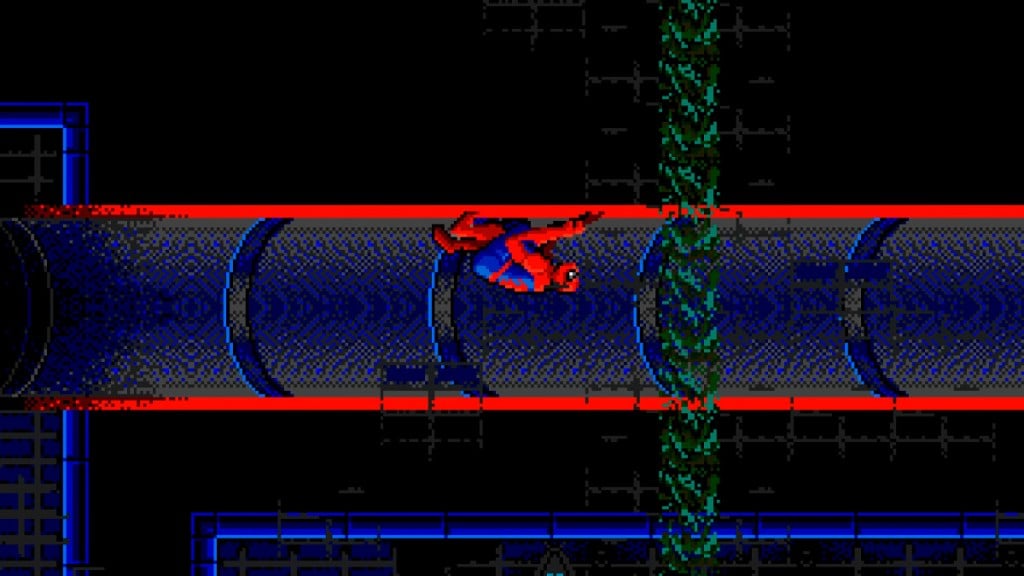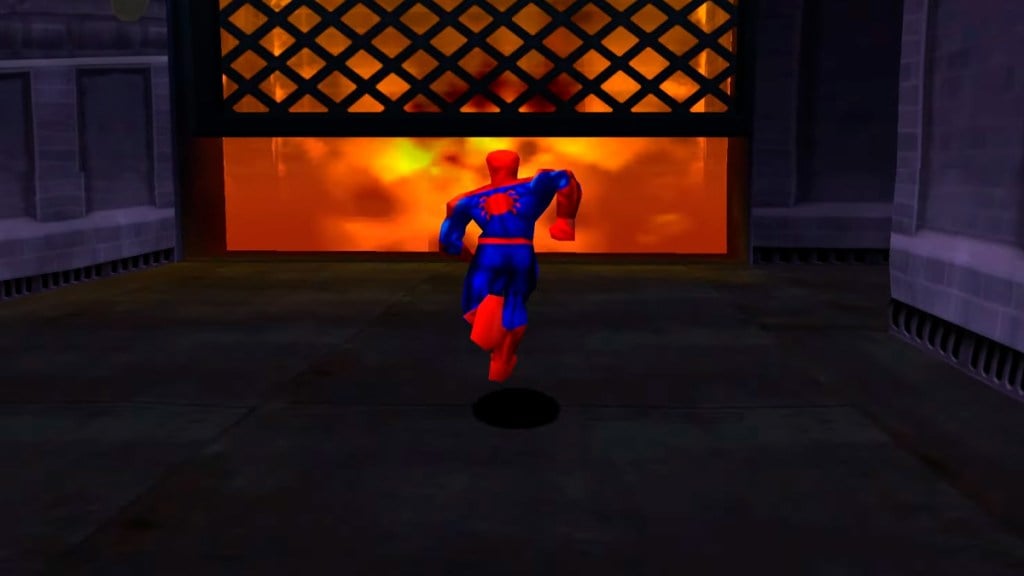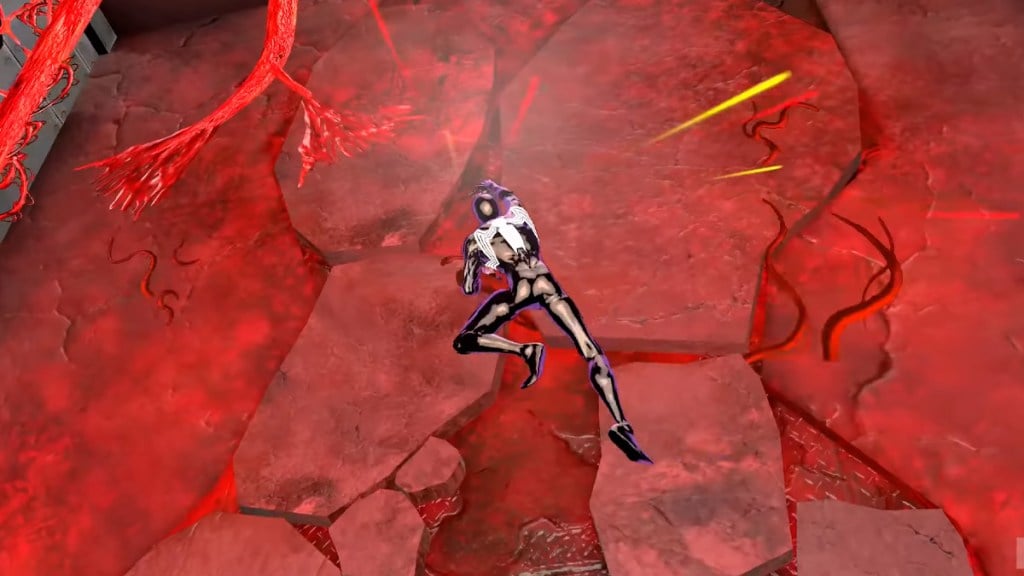Spiderman has been swinging his way into our hearts for nearly six decades. Still, it took quite some time before players could experience the same thrill on their gaming consoles. Spiderman games have evolved from the early Atari 2600 days to the cutting-edge PlayStation 5. Let’s explore how several companies have shaped what we love about Spidey games today.
80’s: The Early Web-Swinging Days

Spiderman first appeared in comic books in 1962, thanks to the creative minds of Stan Lee and Steve Ditko. However, it would be nearly two decades before players could take control of the friendly neighborhood hero in their living rooms.
In 1982, Parker Brothers published the first Spiderman game for the Atari 2600, developed by a single person, Laura Nikas. The game was called Spiderman, which lets you know those were simpler times. This vertical-scrolling game saw Spidey defusing bombs planted by the Green Goblin while climbing up a building. Despite the limitations of the Atari 2600, Spiderman’s debut in gaming was a commercial success.
In 1984, Spiderman went from climbing buildings to a text adventure game in Questprobe: Spiderman. Believe it or not, it’s a puzzle-solving game that debuted Spidey to PC Gaming.
90’s: The Side Scrolling, Beat-‘Em-Up Formula

The Amazing Spiderman and Captain America in Dr. Doom’s Revenge – which is way too long a name for a game – was completely different. This entry did away with all text and took the form of a sidescrolling game. In it, you control both superheroes as they battle iconic villains from the Marvel universe in 1989.
This game would set the groundwork for future games in the late 80’s and early 90’s. They would continue to feature sidescrolling Spidey in New York City. The Amazing Spiderman (1989), Spiderman vs. The Kingpin (1991), and Spiderman: The Video Game (1991) would follow this same formula. In fact, it was the latter that added a couple of beat-em-up arcade flavors into the mix.
Only some, like Nintendo, dared put their own difficulty spin on their Spiderman games. Return of the Six was a particularly tough Spiderman since it featured challenging gameplay with only one life and one continue.
Related: Best Spider-Man Comics to Read To Prepare for Marvel’s Spider-Man 2
The Game Boy followed the sidescrolling formula but also emphasized web-slinging and adventure. The Amazing Spiderman 3: Invasion of the Spider-Slayers is a classic, black-and-white Spidey game where Spiderman faces robotic threats.
While 2D web-slinging and beating up baddies was fun, it was clear that the games lacked any sort of depth plot-wise. In 1994, however, Spiderman joined forces with Venom in Spiderman and Venom: Maximum Carnage. This game was based on a comic book storyline, marking a shift in how Spiderman games incorporated comic book narratives.
Games began to come out more often in the late ’90s. Inevitably, this led to some lackluster titles like Spiderman and Venom: Separation Anxiety, which did not match the acclaim of the original due to repetitive gameplay and a lack of cutscenes.
The 3D Gem of the 2000’s: Activision’s Spiderman

By 1995, Acclaim and LJN released their final Spiderman game before the license shifted to Activision. Activision would then go on to release the first 3D Spiderman: Spiderman. Yep, just Spiderman again.
The year 2000 marked the arrival of Spiderman for the PlayStation. It introduced an action-adventure game that involved an imposter Spiderman and multiple villains. It became a commercial success and laid the foundation for the future of Spiderman games.
The Game Boy Color received a sequel, but now in not-black-and-white, Spiderman 2: The Sinister Six. This one followed the story of Mary Jane being kidnapped by the Sinister Six. Then, the Game Boy Advance contributed Spiderman: Mysterio’s Menace. While these were quite solid entries, players already had a taste of 3D Spiderman. These 2D sidescrolling sticklers were weak opponents now.
The Mid-2000s: The Activision Era
Activision had its fair share of Spiderman titles web-slinging into the gaming scene. The journey continued in 2002 with Spiderman: The Movie, a game adaptation of the 2002 Spiderman movie. This game was a pioneer, introducing aerial combat and allowing players to swing through the iconic skyscrapers of New York City. It was the first taste of what it’s like to be Spiderman.
Then came 2004, the year that brought Spiderman 2 to life. Tied to the second Tobey Maguire Spiderman movie, it wasn’t just a game but an open-world action-adventure masterpiece. Players swung through the sprawling Manhattan skyline, enjoying the freedom of web-slinging. Solid storylines were also starting to become a thing in video games. This game’s engaging storyline made them feel like the friendly neighborhood Spiderman.
In 2005, Activision turned the game world upside down with Ultimate Spiderman. This action-adventure gem explored the intriguing shared origins between Peter Parker and Eddie Brock. What set this game apart was its incredible art style that flawlessly captured the essence of the comic books.
2006 saw a return to sidescrolling beat ’em ups with Spiderman: Battle for New York on the NDS and GBA, set in the thrilling Ultimate Marvel Universe. It was a reminder that a classic style can sometimes still pack a punch.
In 2007, Spiderman 3 got its own dedicated video game and the debut of the notorious black symbiote suit, which is my absolute favorite Spidey suit. Meanwhile, Spiderman: Friend or Foe arrived on the scene. It pits Spiderman and his allies against enigmatic holographic avatars, adding a new twist to the superhero formula.
The year 2008 brought Spiderman: Web of Shadows to the table. This game blended the various gameplay styles seen in Spidey games over the years. It seamlessly combined open-world exploration with 2.5D scrolling beat ’em-up action. It married all the elements that had made Spidey games great, catering to all Spiderman fans.
The Early 2010s: Beenox’s Grain of Sand

Beenox, the creative force behind several Spiderman games, has left an indelible mark on the world of web-slinging heroes. The journey began in 2010 with Spiderman: Shattered Dimensions, a groundbreaking title that shattered the boundaries of Spiderman lore. This game introduced four versions of Spiderman from alternate universes. Ladies and gents, this was a tantalizing glimpse into the “Spider-Verse” concept. It was a quantum leap in the evolution of Spiderman gaming.
Just a year later, in 2011, Beenox unleashed Spiderman: Edge of Time. This game pushed the envelope with its time-traveling elements. We were treated to an interconnected experience as they alternated between two Spidermen for the first time.
Then, in 2012, the release of The Amazing Spiderman movie saw Beenox swing into action with a corresponding game adaptation. The Amazing Spiderman was more than a tie-in; it offered open-world action-adventure gameplay. It’s a game that puts us in the iconic red and blue suit to explore New York City in all its glory. The game proved that Spiderman was at his best when he had room to roam.
The story continued with The Amazing Spiderman 2 in 2014, which introduces a host of new villains and allies. The game expanded upon the groundwork laid by its predecessor.
However, Beenox’s Spiderman games haven’t always swung effortlessly through the city. Their reception has been as varied as the hero’s rogues’ gallery. Some titles have received high praise for their innovation, pushing the boundaries of what’s possible in a Spiderman game. Others have faced criticism for repetitive missions and a lack of depth.
The Late 2010s and Early 2020s: Insomniac Smoked the Competition

Insomniac Games rewrote the rulebook for Spiderman games in 2018 with the release of Marvel’s Spiderman for the PlayStation 4. This spectacular open-world action-adventure title gave us the keys to the city as Spiderman. It clearly didn’t take long for it to swing its way into the record books for first-party PlayStation game sales.
In 2020, the web-slinging fun continued with Spiderman: Miles Morales. This chapter in The Spider-Verse puts Miles Morales front and center, offering a fresh take on the iconic hero’s journey. It was a reminder that there’s room for more than one Spiderman in the gaming world, and it introduced players to a new and exciting web-slinging style.
Insomniac’s Spiderman games’ standout features are their fluid and intuitive web-swinging mechanics. It’s not just about getting from point A to point B; it’s about feeling like Spiderman while doing it.
But Insomniac’s Spiderman games are more than just agile web-swinging. They are also celebrated for their narrative-driven experiences. The storytelling is at the heart of these games, delving deep into Spiderman’s world, challenges, and character growth.
The history of Spiderman games is a tale of evolution and innovation. Each era and gaming company leaves its unique mark on the franchise. From humble beginnings to modern top-tier games, Spiderman’s gaming journey has been nothing short of amazing. With the promise of “Marvel’s Spiderman 2” on the horizon, the future looks bright for Spiderman fans and gamers alike.







Published: Oct 17, 2023 02:13 pm